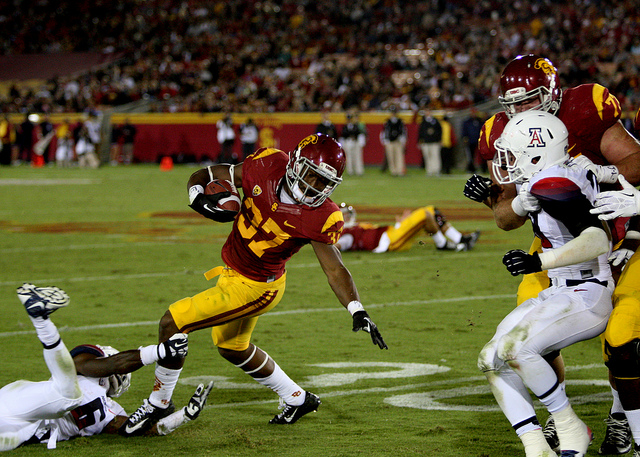Buck Allen Vs. Paul Perkins: Who's The Better Running Back?

With both sides sporting explosive offenses, the X-factor could be either team’s running backs, who are tasked with keeping the opposing offense off the field and keeping their respective offenses rolling. USC’s Javorius Allen and UCLA’s Paul Perkins are arguably the two best running backs in the Pac-12, ranking first and second in the conference in rushing yards.
In a matchup where the smallest advantage could spell victory, which side has the better running back?
In order to determine this, we’ll compare each player’s stats, the weapons that surround them, and their importance to their team’s success.
To start, here are each player’s statistics entering Week 13:
Javorius Allen: 217 carries, 1184 yards, 5.5 YPC, 8 TDs; 32 catches, 383 yards, 12.0 YPC, 1 TD
Paul Perkins: 189 carries, 1169 yards, 6.2 YPC, 6 TDs; 24 catches, 198 yards, 8.3 YPC, 2 TDs
Based off the stats, you’ll notice that, despite a 15-yard advantage for Allen, he has 28 more carries than Perkins, which might also explain the two extra rushing touchdowns Allen has. Perkins averages more yards per carry, but fewer yards per catch.
This gives Allen a combined 249 touches with 1567 all-purpose yards and nine total touchdowns, compared to 213 touches with 1367 all-purpose yards and 8 total touchdowns. Both players lead their teams in all-purpose yards, but Allen has 36 more touches, 200 more yards and an extra touchdown. Advantage to Buck Allen?
SEE ALSO: USC Hopes To Regain Dominance In UCLA Rivalry
Not necessarily. Comparing their stats can cause some issues, as the teams have played fairly different schedules with varying strengths of run defenses. To combat this, we can only take their stats from the games against opponents they’ve had in common, which are Arizona State, Utah, California, Colorado and Arizona.
Javorius Allen: 118 carries, 637 yards, 5.4 YPC, 6 TDs; 16 catches, 201 yards, 12.6 YPC, 0 TDs
Paul Perkins: 86 carries, 580 yards, 6.7 YPC, 4 TDs; 8 catches, 86 yards, 10.8 YPC, 2 TDs
After making this adjustment, we still get the same results as the overall season: Allen’s increased touches give him more opportunities for yards and touchdowns, while Perkins has better rushing yards per carry and fewer yards per catch than Allen. The only difference is that they have the same amount of touchdowns. Allen has 134 touches for 838 yards and six touchdowns in these five games, while Perkins has 94 touches for 666 yards and six touchdowns.
UCLA’s biggest weapon is Hundley, who is just as much of a threat to run the ball as Perkins, with seven rushing touchdowns on the season to Perkins’ six. The junior gunslinger leads all Pac-12 quarterbacks in rushing yards, giving UCLA the 29th-ranked rushing offense (215.8 yards per game) compared to 66th for USC (163.1 yards per game).
Agholor and Smith help give Allen some breathing room, as defenses have to account for their ability to make big plays, but they can still load the box if they’re likely to run the football. Similarly, opposing defenses have to respect Hundley’s ability to keep the ball on a read-option and beat them with his own legs, giving Perkins a little extra space once he’s confirmed as the ball-carrier.
Allen accounts for 72.6% of his team’s rushing yards, with his only major competition being running back Justin Davis (432 yards, 3 TDs). Perkins accounts for 54.2% of his team’s rushing yards, with four other players on his team amassing over 100 yards.
Both Allen and Perkins are excellent running backs, and their respective teams are thrilled to have them leading their run-game. However, UCLA has more options in the backfield, allowing Perkins more rest and giving him more breathing room with Hundley a threat to run as well. Allen is generally out for extended periods of time, with small breaks to rest with Davis running the football, but Davis is known to have ball-security issues at times, leading coach Steve Sarkisian to bring Allen back out. With Kessler not a big threat to keep it and run, Davis becomes the main target in the backfield.
Because of his increased workload, both in the running and passing game, similar efficiency, and his value to the success of the USC offense, I’d give the nod to Javorius Allen. However, Perkins isn’t too far behind, and I’m sure any team would be thrilled to have either back taking the bulk of ’s carries.
Reach Staff Reporter Andrew Schultz here or follow him on Twitter.



